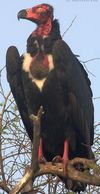
Development (Greed) vs. Conservation (17 December)
Red-headed Vulture (22 October)
Bengal Florican (16 October)
Trash Woes (6 October)
Douc Monkey (4 October)
Trees and Monks (18 September)
Illegal and Public (15 September)
Cheaper and Greener! (9 September)
Fire-fighting Monks (30 August)
Cambodian Leopards (10 May)
Irrawaddy Dolphins (17 April)
Sanctuary for the Ibises (16 April)
Poaching Elephants (5 April)
Slender-Billed Vultures (16 February)
The government Environment Minister recently commented that "Cambodia" should be able to extract and use the natural resources located in the country's environmentally protected areas. This comes at a time when legislation that environmental groups have long fought for could make these areas off limits to development. The minister said that Cambodia should effect a balance between development and preservation of its environment. That tension is present in every country, but here development is the codeword for "more money for me (the officials) and my friends." The six largest conservation groups in the country have asked to meet with the minister to ask how he is going to deal with development pressure from activities like road building, mining, agricultural concessions (huge plots made available to commercial enterprises, usually linked to officialdom), and exploration work.

Another Cambodian bird recently placed on the Critically Endangered list--facing an extremely high risk of extinction in the immediate future--is the Red-headed Vulture. In the early 1990s the birds numbered in the hundreds of thousands--mostly in India and Nepal--but since then their population has been cut in half every two years until they now number less than 400. The main factor in their decline is thought to be the drug Diclofenac which is used to treat cattle. Unfortunately it is extremely toxic to the vultures who feed on the carcasses of dead cattle. Diclofenac is not used in Cambodia so there is hope that the population could recover here with sufficient awareness and attention to their plight. [Photograph from oiseaux.net]
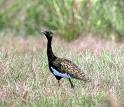 The Bengal florican is a bird known as a bustard and was once abundant in Cambodia. Its numbers there have now dwindled to maybe 900 birds. The species has had an even more dramatic decline in its other habitat in Tibet and Nepal. The World Conservation Union recently re-classified the Bengal florican as critically endangered and said it could be extinct within Cambodia in five years. Its decline has been caused by the destruction of the grasslands which are its natural habitat.
The Bengal florican is a bird known as a bustard and was once abundant in Cambodia. Its numbers there have now dwindled to maybe 900 birds. The species has had an even more dramatic decline in its other habitat in Tibet and Nepal. The World Conservation Union recently re-classified the Bengal florican as critically endangered and said it could be extinct within Cambodia in five years. Its decline has been caused by the destruction of the grasslands which are its natural habitat.

From 2004 to 2006 the amount of waste dumped at Phnom Penh's Stung Meanchey landfill increased by 20% to 327,000 tons. That is considered to be only a small part of the trash generated by the city, though, with the rest of it deposited on roadways and empty lots, especially in the outlying urban areas where there is little or no trash collection. Part of the problem is a private-public company partnership currently tasked with trash collection. The working arrangement does not always insure that all areas have rubbish collected, partly because of jurisdictions problems and partly because of inadequate fees charged for the service and because of non-payment of fees by those receiving the service. It is estimated that 30% to 40% of Phnom Penh households do not pay the fees for the collection of their trash. The fees are part of the electricity bill received every month but since many people do not have electricity, there is no pressure on them to pay what is owed for the garbage service.
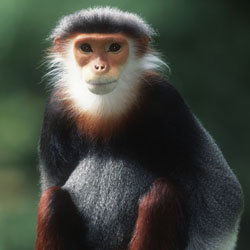
The World Conservation Union has published its 2007 "Red List" which is the most comprehensive list of the world's endangered species. The douc monkey, found in Cambodia, Laos, and Vietnam, has been raised to endangered status and, according to the report, faces a very high risk of extinction in the near future. This particular monkey--often considered the most beautiful of all the primates because of its coloring--lives in the middle canopies of rainforests and rarely descends to the ground. It feeds on leaves and fruits. Its decline is attributed to excessive hunting by indigenous people and military personnel; loss of habitat; and degradation of the habitat by military conflict, especially the spraying of herbicides and defoliants during the Vietnam War. Photo from World Wildlife Foundation

In 2005 a politically aware Buddhist monk named Heik Sopheap began the Association of Buddhists for the Environment. He spread the message that Buddha teaches reverence for the environment and monks are a special part of that message because of their natural relationship with the forest where Buddha was born, achieved enlightenment, and then began his new way. Now ABE has joined with the US-based Conservation International to promote the message of environmental conservation to their neighbors in a small part of Koh Kong Province. Nine monks living in the area are specially trained to participate in wildlife blessing ceremonies and in ceremonial walks through the protected forest in order to create environmental consciousness among the people in the mountainous area. It is just a small-scale pilot project for one year, but the monks hope the program can be expanded to take the message to other areas and other populations.
In 2006, an illegal gem-mining operation in Ratanakkiri Province was ordered closed by authorities. Now a few months later, it has resumed mining with expanded operations that use high-pressure jets of water to blast away hillsides in search of sapphires and rubies. The Deputy Governor has said police were dispatched to stop the mining and get the miners to sign a document agreeing not to resume mining. Provincial police officials say, though, they fear that the miners have paid off district officials in order to continue the work. The Deputy Governor said that he had not personally received any bribes but didn't know if other officials had. In the meanwhile, the illegal mining--openly publicized in the newspaper--continues, polluting the local river and affecting the health of villagers and damaging their crops.
Cambodia is having problems with a dengue fever outbreak this year, made worse by the shortage of a chemical called Abate which is put into clean water to kill mosquito larvae. An alternative is available, though: guppies, or "seven-color fish" as they are known in Cambodia. Two or three of the fish are all that is necessary to keep a 150-gallon container free of mosquitoes. They don't cost much and they prevent more chemicals from being introduced into the environment. There are several problems with the use of the fish, though. One problem is that they do nothing to solve the problem of mosquitoes breeding in water that gathers on the ground around houses or at construction sites. Some people, too, are reluctant to put fish in their drinking water. And 25% of the fish go missing, probably because the children find them attractive and capture them to play with them!
Buddhism is focused on the individual and helping him or her reach nirvana. There is not much of a community dimension or social consciousness. But Buddhism does have a fundamental appreciation for nature. In 2005 ten Buddhist monks got together to form the Association of Buddhists for the Environment, and they have established a network of fire-fighting monks who mobilize to battle forest and brush fires that erupt in Kampong Chhnang province. Now grown to more than twenty monks from four pagodas, have become a significant force in reducing the damage caused by wildfires, both by their fire-fighting efforts and their sensitizing the villagers to better protect their forests.
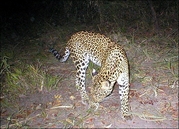
Recently the World Wildlife Fund released pictures taken of a rare Cambodian leopard and its cub. The photo, made with a camera trap, has excited wildlife officials as a sign that animals nearing extinction may still be reproducing. The photograph was taken in February but was just now released because poachers sometimes use information gained by the wildlife NGO to pursue the endangered animals.
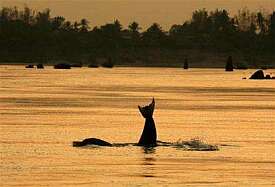 The upper reaches of the Mekong River in Cambodia are home to the freshwater Irrawaddy Dolphin, a popular tourist attraction for local people and foreigners alike. Like so many species, however, the dolphins are under threat because of destruction of their habitat. In 2006, the World Wildlife Fund estimated there were just 100 of them left. But now government conservationists are saying that there are between 150 to 160 of the aquatic mammals in the Mekong. Wildlife officials in Australia who are studying the dolphins doubt these figures, though, saying that only about twenty dolphin babies were born in the last year and six of these are known to have died.
The upper reaches of the Mekong River in Cambodia are home to the freshwater Irrawaddy Dolphin, a popular tourist attraction for local people and foreigners alike. Like so many species, however, the dolphins are under threat because of destruction of their habitat. In 2006, the World Wildlife Fund estimated there were just 100 of them left. But now government conservationists are saying that there are between 150 to 160 of the aquatic mammals in the Mekong. Wildlife officials in Australia who are studying the dolphins doubt these figures, though, saying that only about twenty dolphin babies were born in the last year and six of these are known to have died.

The national bird of Cambodia is the giant ibis, an extremely rare and beautiful bird. There are fewer than 250 of them left in the world. Another ibis, the white-shouldered ibis has even fewer surviving members: 23 in Borneo and about 200 in Cambodia. Both of them have a natural habitat in Preah Vihear province near the Laotian border, and enterprising wildlife officials have managed to help the local villagers take responsibility for preserving the two species and at the same time profit from their efforts. They protect the nests of the critically endangered birds and pledge not to hunt or disturb them. But they are allowed to lead tours of dedicated bird-watchers to the area and have developed this into a sustainable livelihood. They have a spartan guesthouse for $4 a night and they charge $5 a day for a guide. If the elusive birds are actually spotted, the bird-watchers give $30 to the community development fund; if the ibises remain hidden, the cost per visitor is $15. So far the scheme is working and everyone is pleased.
Ratanakiri is a northeastern province of Cambodia, the home to many of the ethnic minorities and to much of the country's wildlife such as elephants. Recently a domestic elephant there that had been with a family for more than 60 years was poisoned during the night while chained up just 300 meters from his owner's house. Then the elephant's tusks were sawed off. Such poisonings of wildlife have become more common in the past three years, and rights groups say there has been no crackdown and prosecution, so the killings are likely to continue.
 Slender-billed vultures are listed as critically endangered by the World Conservation Union, so wildlife officials were delighted to discover eight nests of the extremely rare birds in northeastern Cambodia's jungles. The birds went into a precipitous decline because of the use of the anti-inflammatory medication Diclofenac which is given to cattle. The inexpensive drug is used for a broad range of ailments in cattle, but it destroys the kidneys of the vultures who eat dead cattle. The concentration of vulture nests in Cambodia's Stung Treng province is the only known breeding colony of the vulture in Southeast Asia.
Slender-billed vultures are listed as critically endangered by the World Conservation Union, so wildlife officials were delighted to discover eight nests of the extremely rare birds in northeastern Cambodia's jungles. The birds went into a precipitous decline because of the use of the anti-inflammatory medication Diclofenac which is given to cattle. The inexpensive drug is used for a broad range of ailments in cattle, but it destroys the kidneys of the vultures who eat dead cattle. The concentration of vulture nests in Cambodia's Stung Treng province is the only known breeding colony of the vulture in Southeast Asia.